Modern chess includes a panoply of ‘Indian’ openings, which share a common root in the starting moves 1 d4 Nf6 and include the King’s Indian, Nimzo-Indian, Queen’s Indian, Bogo-Indian, and Old Indian. But before 1900, the prevailing wisdom held that it was advisable for Black to contest the centre with a pawn advance. So the ‘Indian defence’, whose main characteristic was the fianchetto of the king’s bishop to g7, was a rarity — at least in games whose records survive. It was championed, with considerable flair, in a remarkable series of games played in Calcutta.
John Cochrane was a Scottish barrister who practised in India for much of his career. He was at one time the president of the Calcutta chess club, but as an accomplished player it was not easy for him to find suitable opposition. In 1848 he encountered probably the strongest player from suburban Calcutta, a Brahmin named Moheschunder Bonnerjee (of which various spellings have been seen). Over the next decade, the two played hundreds of games, which were recorded in meticulous detail by Cochrane, who was working on a manuscript entitled ‘Loose Indian Chess Leaves’. A transcript of this material is part of the John G. White Chess and Checkers Collection, and can be found online at the website of the Cleveland Public Library.
Cochrane’s play shows considerable imagination; the gambit which bears his name (1 e4 e5 2 Nf3 Nf6 3 Nxe5 d6 4 Nxf7!?) is typical of his approach. He remained, overall, a 2 to 1 favourite in their contests, but Bonnerjee’s play often makes a powerful impression, and the game below is a gripping example. One plausible theory holds that Bonnerjee’s opening choices were influenced by the rule in common use in India at that time, which placed restrictions on pawn advances of two squares. In a note to his 23rd move, Cochrane wrote: ‘This secures my opponent the game. The play of Moheschunder throughout is very good.’ In fact, the complications were just getting started!
John Cochrane–Moheschunder Bonnerjee
Calcutta, 1853
1 e4 d6 2 d4 g6 3 c4 Bg7 4 f4 Nf6 5 Nc3 O-O 6 Nf3 Nowadays, this is known as the ‘Four pawns attack’ variation of the King’s Indian defence. 6…c6 7 Bd3 e5 A good time to strike. The only way for White to win a pawn is with 8 dxe5 dxe5 9 Nxe5, but then Na6 promises Black active play. 8 fxe5 dxe5 9 d5 b5! An excellent dynamic thrust. 10 Bg5 h6 11 Bxf6 Bxf6 12 cxb5 cxd5 13 Nxd5 Bg7 14 Bc4 Nd7 15 O-O Bb7 16 Kh1 Nc5 Despite White’s extra pawn, Black’s bishop pair and safer king promise long-term counterchances. White’s next move is a mistake, as the rook belonged on the open f-file. 17 Re1 Rc8 18 b4 Ne6 19 Bb3 Kh7 20 Rc1 Rxc1 21 Qxc1 Qd7 22 Qe3 Nd4 23 Nxd4 exd4 24 Qd3 f5 25 Qh3 Re8 26 Qh4 g5 27 Qf2 Kh8 28 h4 Rxe4 29 Rxe4 fxe4 30 Nf6 Qc7 Instead, 30…e3! gives Black a decisive advantage, but now White has an amazing resource. 31 Nh5 31 Qf5! Qc1+ 32 Bd1!! Qxd1 33 Kh2 Bxf6 34 Qxf6+ is drawn by perpetual check. Qc1+ 32 Kh2 Qc7+ 33 g3 e3 34 Qf5 Qc1 35 Bd5 Bxd5 36 Qxd5 Qc2+ 37 Kh3 Qg6 38 Nxg7 g4+ 39 Kh2 Qc2+ 40 Kh1 40 Qg2!! was an unlikely saving opportunity. After 40…d3 41 Nf5 e2 42 Qa8+! Kh7 43 Nd4! White can draw amid fantastic complications. But not 42 Nd4? e1=N!! 43 Qxc2 Nxc2 and Black soon wins. 40…Qd1+ 41 Kg2 Qe2+ 42 Kh1 42 Kg1 Qf2+ comes to the same thing. Qf3+ 43 Qxf3 gxf3 (see diagram) 44 Kg1 d3 45 Nf5 e2 46 Kf2 White resigns before d3-d2 arrives.
Got something to add? Join the discussion and comment below.
Get 10 issues for just $10
Subscribe to The Spectator Australia today for the next 10 magazine issues, plus full online access, for just $10.
You might disagree with half of it, but you’ll enjoy reading all of it. Try your first month for free, then just $2 a week for the remainder of your first year.

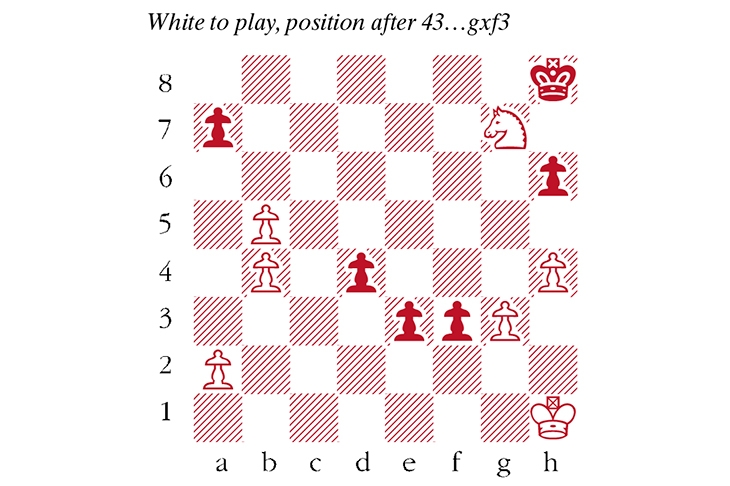
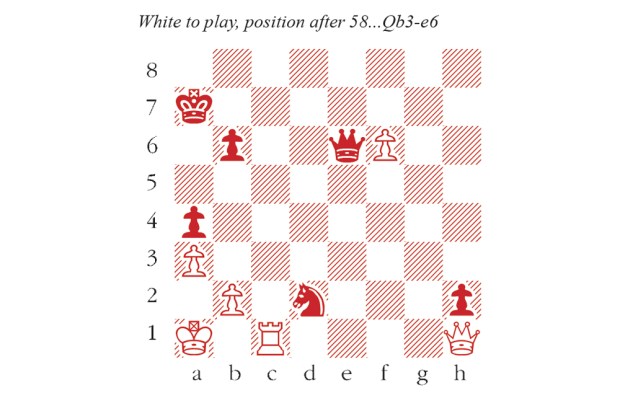
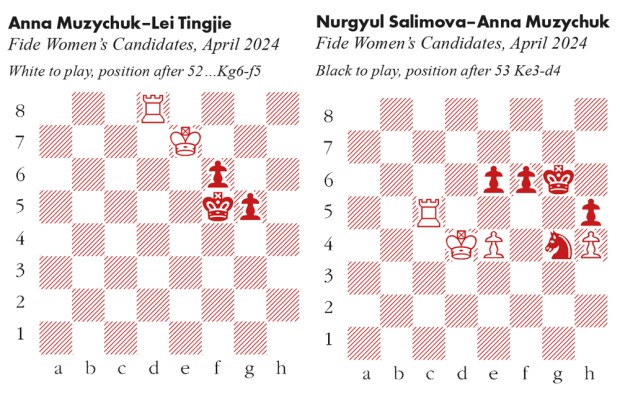
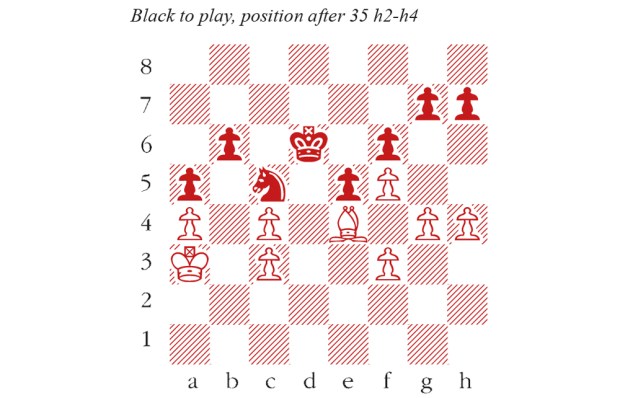
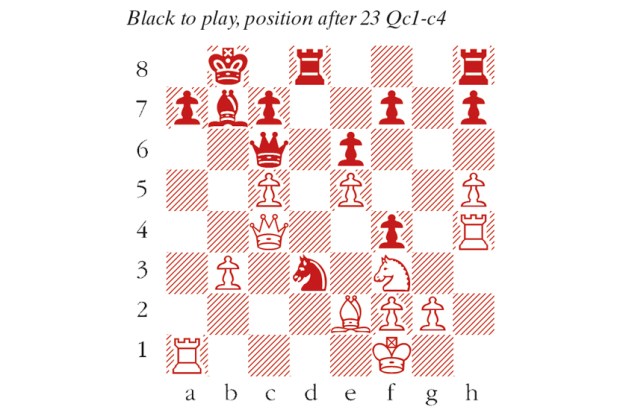
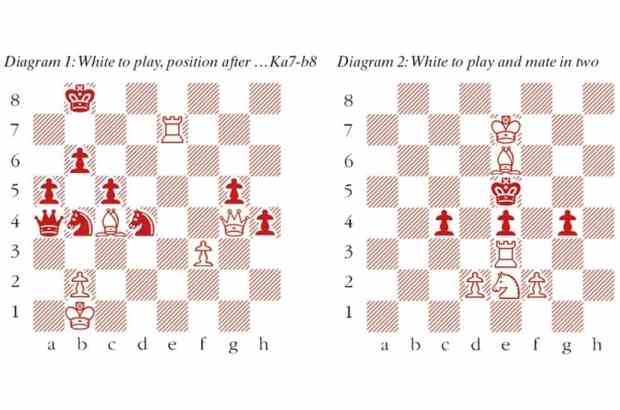
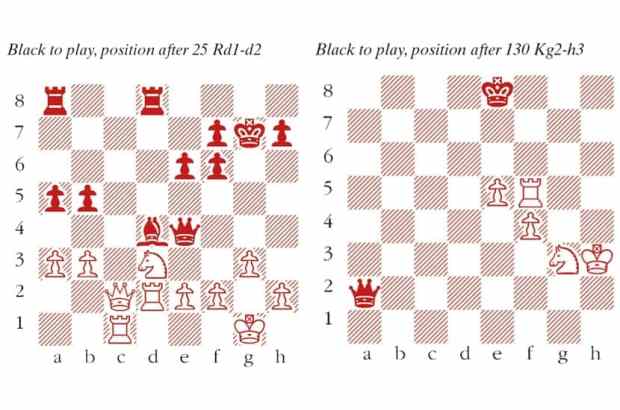






Comments
Don't miss out
Join the conversation with other Spectator Australia readers. Subscribe to leave a comment.
SUBSCRIBEAlready a subscriber? Log in